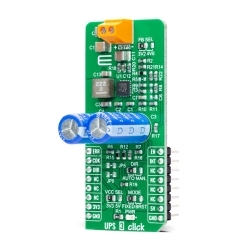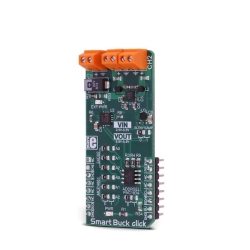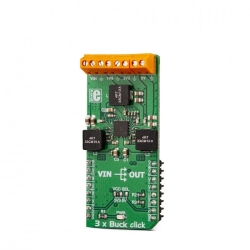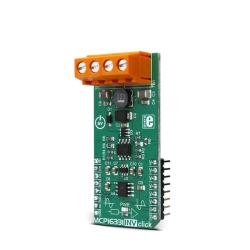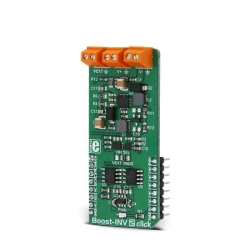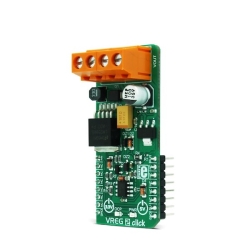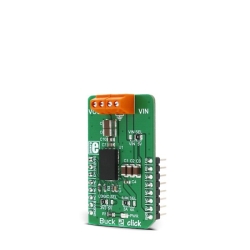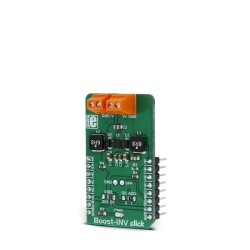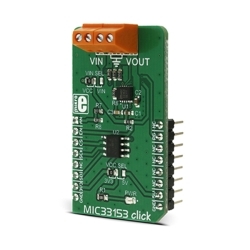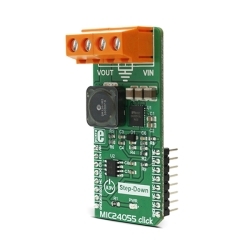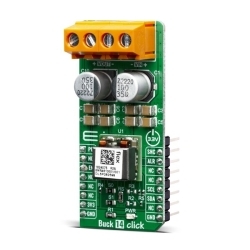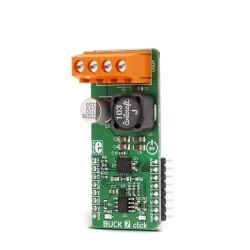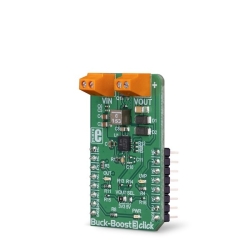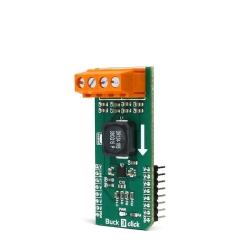MIKROE Buck 12 Click
Buck 12 Click is equipped with the MPQ8632, a synchronous step-down converter, from Monolithic Power Systems (MPS).
Product Overview
Buck 12 Click is a high-efficiency step-down converter which provides 3.3V on its output, derived from the connected power supply voltage, in the range from 4.2V to 18V. Buck 12 Click is based on the MPQ8632, a highly efficient DC-DC step-down converter. In addition, Buck 12 Click offers monitoring the stability of the input and output voltage by employing an additional A/D converter circuit. Due to its high efficiency, MPQ8632 allows the Click board™ to easily deliver up to 4A of current. It features a package which enables a low noise performance, high efficiency, and very compact size, while maintaining compability with higher current ICs from the family.
Buck 12 Click is supported by a mikroSDK compliant library, which includes functions that simplify software development.
The MPQ8632 has a wide voltage input range, which is one of its key features. It uses Constant-On-Time (COT) control mode to provide fast transient response and ease loop stabilization. It also features a set of standard protection options, found on many similar devices: over-current protection, over-voltage protection and thermal shutdown, etc. The Click board™ can be used for a wide range of applications that require 3.3V, including field embedded applications, sensors, PLC modules, video surveillance systems, and similar applications that require step-down conversion to 3.3V.
Buck 12 Click is equipped with the MPQ8632, a synchronous step-down converter, from Monolithic Power Systems (MPS). This is an advanced integrated step-down converter, which requires a minimum number of external components, readily available on the market. It utilizes a peak-current-mode control architecture, which along with the automatic switch-mode switching, ensures a very good efficiency. The MPQ8632 buck converter features over-current, under-voltage, and thermal protection, making Buck 12 Click a robust and reliable power supply solution.
The output voltage is determined by the feedback voltage on the FB pin. The output voltage is set to 3.3V making it usable with most embedded applications, allowing them to be powered from the same source, like the rest of the application, which may use a higher voltage for its operation. This is a common-case scenario in various field applications where a relatively high voltage is required i.e. for servos, step motors, displays, etc.
When there is overload at the output, the low-side MOSFET will allow the inductor current to drop. It will remain open until the current through the inductor falls below the limit. If the FB voltage drops too much during the overload, the device enters the hiccup mode, in which the device disables the output power stage, discharges the soft-start capacitor and then automatically retries soft-start.
The MPQ8632 is able to automatically switch between different operating modes, depending on the current through the load. At very light loads, the device is operated in skip mode. In this mode HS-FET turns on for a fixed interval determined by the one-shot on-timer. When the HS-FET turns off, the LS-FET turns on until the inductor current reaches zero. The LS-FET driver turns into tri-state (high Z) whenever the inductor current reaches zero. This way, the device is in an idle state, while the light load consumes energy stored within the coil. This greatly improves the efficiency when a light load is used. This is also called discontinuous conduction mode (DCM).
When heavily loaded, The MPQ8632 is automatically switches to heavy load operation or continuous-conduction-mode (CCM). In this mode, when VFB is below VREF, HS-FET turns on for a fixed interval determined by the one- shot on-timer. When the HS-FET turns off, the LS-FET turns on until the next period. In CCM operation, the switching frequency is fairly constant and is also called PWM mode.
Packed in QFN casing (3X4mm), the MPQ8632 occupies a very small area on the PCB. Combined with the low count of external components it requires, the MPQ8632 leaves enough space for an additional IC to be used. This Click uses the MCP3202, a Dual Channel 12-Bit A/D Converter which uses the SPI interface, from Microchip. It allows monitoring the input and output voltages over the SPI interface. This ADC is powered from the +5V mikroBUS™ power rail. The same voltage is used as a reference. The Click board™ itself requires an external power supply to be connected at the input terminal, labeled as VIN. The VOUT terminal provides the connected load with the regulated 3.3V voltage.
Features & Specs
- Interface: SPI
- Compatibility: mikroBUS™
- Dimensions: 57.15 x 25.4mm
- Input Voltage: 5V
- Output voltage (VOUT): 3.3V
- Output current (continuous): Min. 0A, Max. 4A
Documentation
Customer Reviews
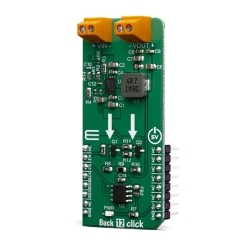
Stock and Customer Discounts
Available Discounts
- $19.90 | 25+ units
- $18.86 | 100+ units


